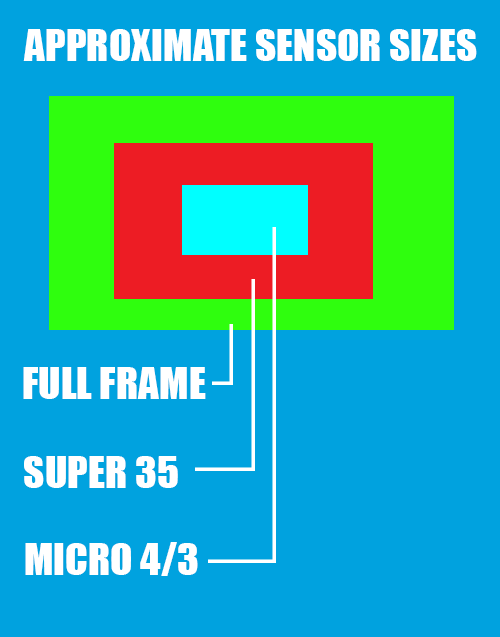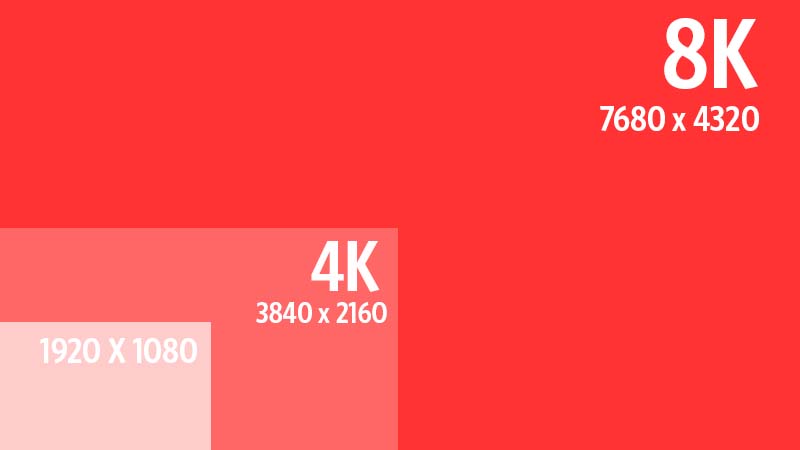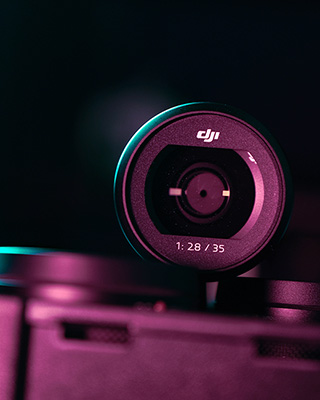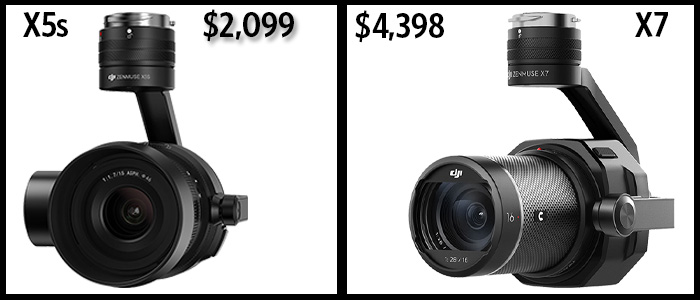What Lens Should I Get For The DJI Inspire 2?
Zenmuse X5s or Zenmuse X7?
5 Min. Read*

In this week’s post we’ll break down the pros and cons of DJI’s Inspire 2 Cinema Lenses, the Zenmuse X5s and Zenmuse X7!
DJI made 5k quality footage available to consumers in 2016 with the release of the Zenmuse X5s. They upped the ante in November 2017 with the release of the Zenmuse X7. This newer model offers a host of features that we’ll cover together in the next few minutes. Among the highlights, this lens can provide 6k quality footage at 30 frames per second! If you want to see some test footage from these lenses, you can take a look at the video we’ve included in this blog. Below the video, we’ll include a detailed break down of our findings!
The X5s carries a micro four thirds sensor onboard. The X7 carries a Super 35 sensor.
This may not make much sense, especially if this is the first time you’re hearing these terms! We’ve created a sensor sizes comparison chart that shows the difference between the micro four thirds, super 35, and the next step up which is full frame sensors.
As you can see here, the Super 35 sensor is significantly larger than the Micro four thirds onboard the X5s. This is the secret to the incredible quality of the Zenmuse X7!
We don’t want to bore you with the science of it all, but basically the larger a sensor the more photons it can capture when it’s open for a set amount of time. If you put the X7’s Super 35 next to the X5s’s Micro 4/3 in the same light conditions and kept them both open to receiving light for the same duration, the X7 would produce a better result.
Now that we understand sensor size is what gives the X7 greater range than the X5s, let’s talk about the major differences in features that are caused by the difference in sensor size…

A PICTURE IS WORTH A THOUSAND PIXELS
The Super 35 sensor gives the Zenmuse X7 the ability to capture 24 megapixel stills. Megapixels are tossed around often when discussing lenses and camera equipment. A megapixel is exactly what it’s name says it is. Mega is a unit prefix in the metric system for the number 1 million. So a megapixel just means 1 million pixels! Now when we look back to the X7, we know that its’ 24 million megapixel camera means each image holds 24 million pixels to colorize, edit, and pull any creative direction we want!
The X5s is incredibly impressive as well with its 20.8 megapixel camera, however we understand just how much of a difference this can be! 20.8 megapixels leaves each image with over 3 million less pixels than the X7 to capture and edit.
A camera’s image quality usually correlates to great video performance as well. Of course there are many factors that affect video capabilities! But, a video is only a collection of images. So great performance on the image side is usually indicative of great performance on the video side which we’re about to get into.
The Zenmuse lens series boasts some incredible capabilities in the video space. Let’s start with the video metric most people judge by… Resolution!
Resolution is the thing you hear about in the TV space often. 1080p Ultra HD, or High Definition, or 4K quality. Resolution for video, just like megapixels for a camera tells us about pixels as well. Video resolution for 720, and 1080 counts the number of pixels that run in a single line from top to bottom of a display screen (uses the height value). Video resolution for 2k, 4k, 8k and others goes by the horizontal number of pixels that run across the screen (uses the width value).

As you can tell from the chart above, each bump up in resolution correlates to a pretty big difference in size! 4k quality footage has double the pixels of 1080, and 8k has double that of 4k. Most major social media applications offer the ability to host 4k quality footage (YouTube, Facebook, Tik Tok, etc.). Technology is ever evolving, and so it’s only reasonable to assume that in the next few years 5k, 6k, and higher resolutions will be the new norm where 4k is today.
Both the Zenmuse X5s and Zenmuse X7 offer resolutions greater than 4k
The X5s offers 5k quality footage at 24, and 30 frames per second. The X7 offers 6k quality footage at 24, and 30 frames per second, as well as 5k footage in the same frame rates as the X5s.
DJI is always working on new systems, as well as upgrades to their more popular series (Mavic, Phantom, Inspire). Other manufacturers are also working on developing drones to compete with DJI’s massive fleet! This means in the next few years, the common capability when it comes to video will likely be 6k and up.
X5s VS X7 PRICE COMPARISON
So when it comes to price, there’s a pretty stark difference! The comparison you see above is for the price of the gimbal mount, and one lens (15 mm. for the X5s, 16 mm. for the X7). To purchase the gimbal alone for the X7 without a lens, it’ll run you $2,899. DJI is constantly working on upgraded lens systems, so don’t sweat it if the X7 is out of range for right now.
Both lenses will offer incredible quality, in fact it’s not very easy to see the difference! The X7 offers additional range for professionals of the video & film trade. Those additional 8,294,400 pixels provided by 6k footage from the Zenmuse X7 can do a lot in the hands of knowledgeable experts.
CLOSING NOTES
MEGAPIXELS MATTER
Megapixels give consumers insight into the quality of a camera’s images. There are many other factors that affect the end result, but greater pixel count usually correlates to greater color information & depth.
RESOLUTION REAPS RESULTS
The resolution a camera can provide is the go-to method of comparison of video cameras. Resolution like megapixels tells consumers how many pixels can be found in each frame. Just like camera greater information usually means greater quality.
CHECK THE PRICE TAG
There is a pretty sizeable gap in price between the X5s and X7 ($2,099 vs. $4,398 for basic kit). You’ll have to compare the features, along with the footage examples in our video, and decide if either lens fits your budget!
ALTERNATIVE OPTIONS
The X5s & X7 were released in 2016 and 2017. Since then, DJI has progressed extensively in their photo and video capabilities. If 5k footage is important, you can consider the Air 2s which offers 5.2k quality video. The Phantom 4 Pro offers 20 megapixel images.



